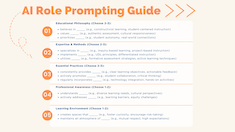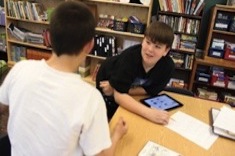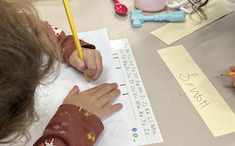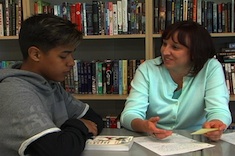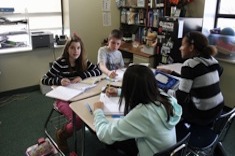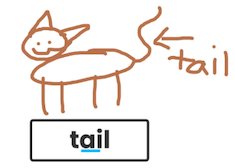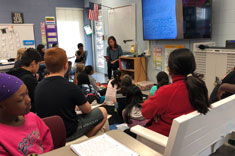Assessment Tools
Making sense of the enormous amount of student data in any classroom or school is probably the biggest challenge we face individually and in our school communities. Here you'll find everything from one-page templates created by teachers for use in their classrooms to videos of staff teams poring over large data sets. We don't have all the answers, but we do provide tools to help you ask better questions as you evaluate students and talk about assessments with your colleagues.
Latest Content
Just Ask Them: Including Students in the Feedback Process
Hypothesizing what our students might be thinking eats into our time to act upon what they’re actually thinking. Heather Fisher suggests, “Let’s just ask the students.” Heather outlines a process for gathering responses from students of all ages and compiling the data to make it useful in determining next steps.
Fostering Independence with Tools
Melissa Quimby tackles the question of how to foster more independence in her students. She considers the way tools can help scaffold independence. Melissa offers an in-depth conversation that examines what tool to create, how to introduce it, and where to store it.
The Right Moment for “I Can” Statements
Mandy Robek reflects on the post-assessments in a new curriculum, and the way students were making simple mistakes that lowered their scores. Mandy experimented with using “I can” statements as part of students’ self-reflection and was impressed by the influence this simple shift had on the post-assessments.
Beyond “I’m a Third-Grade Teacher”: The Power of Role-Specific Prompting in Educational AI
Brian Sepe helps us understand the importance of prompting and offers a framework that will help us be more intentional and specific to leverage AI for our needs.
Can AI Help with Assessment?
Tara Barnett and Kate Mills explore using AI to help with grading student writing. In this practical and insightful article, they share a process for using AI as a co-teacher and their reflection on whether it helped them save time (nope) and made their feedback more useful (yep). They share a downloadable student literary essay reflection sheet that you might want to use in your classroom, too.
Building Thinking Classrooms in Literacy
Inspired by Peter Liljedahl’s Building Thinking Classrooms in Mathematics, David Pittman applies instructional practices to get students thinking for themselves as readers and writers, and to be drivers, not consumers or mimickers of someone else’s way of doing things.
Got Criteria? How to Help Students Engage with Success Criteria
Heather Fisher offers four tips for engaging our youngest students with daily criteria for success.
Alternatives to a Literary Essay: Two-Voice Perspective Poems
Tara Barnett and Kate Mills offer an alternative to writing a literary essay for middle school students. Providing alternative ways to discuss and demonstrate understanding about reading can be a welcome break from an essay for both students and educators, with valuable learning still taking place.
Know/Wonder Chart
Dana Murphy shares the power of a Know/Wonder chart to peek inside the minds of intermediate readers and provide direction beyond assessment data.
Creating a Teacher Notetaking System
Dana Murphy, a reading specialist, guides all teachers in ways to develop a notetaking system that works perfectly because it is personalized.
It’s Time to Admire: Sharing in the Beauty of Students’ Writing
Heather Fisher shares a process to help teachers learn to admire student writers and find the beauty in their work.
Level Two Unlocked: Using the Language of Video Games to Engage Students in the Assessment Experience
Heather Fisher considers the research behind gamified experiences and applies it to a lengthy first-grade phonics assessment. Heather challenges us to gamify assessments to maintain the integrity of the assessment while increasing student engagement.
One-Page Reading Response: A Simple Approach to Complex Assessment
Christy Rush-Levine uses one-page reading responses as a simple culminating activity to provide closure for book clubs. However, the data they offer about readers is far from simple.
Getting to Know Digital Learners: How Playing with Technology Helps Facilitate Our Identities as Learners
As teachers we do many things to get to know our students as readers and writers and mathematicians. Josie Stewart and Hannah Tills lead us to consider how to get to know our students as digital learners.
Student-Planned End-of-Year Celebration
Josie Stewart and Hannah Tills know the end of the school year is full, yet they take the time to reflect and celebrate what learners have built throughout the year by asking students to create a plan for a final celebration.
Creating Progressions to Meet Learners Where They Are
Tara Barnett and Kate Mills share how to create and use learning progressions to support students in deepening their understanding of theme. Download a copy of a theme progression.
Mining the Data
Heather Fisher shares how to rebrand data meetings as mining meetings to turn anxiety and frustration into actionable and meaningful responses to data.
Making Data Review More Personal
Dana Murphy describes an approach to “data-review days” that looks beyond numbers to the faces of kids and talks about all kids in all of their humanity.
Student-Created Assessments
Ruth Metcalfe releases responsibility to her first-grade class to create formative assessments and take ownership in their learning.
Grow and Innovate with Reflection
Julie Cox makes a case for reflection as an essential tool for growth and innovations. She shares simple and powerful steps that will allow all educators to continue to deepen their instructional practices.
Formative Assessment From Share Sessions
Ruth Ayres outlines different kinds of share sessions and different formats for the share, including some that take advantage of technology.
How to Use Students’ Reading Logs as a Formative Literacy Assessment
Matt Renwick reminds us that there is a lot of information available in our classrooms that can inform instruction. Some of it is “hiding in plain sight,” for example reading logs.
Reading Quiz
Gretchen Schroeder shares the way she adjusts her reading quizzes to assess students’ analysis and deep thinking about texts.
Rethinking Late-Work Policies
Gretchen Schroeder asks herself tough questions about her late-work policy for high school students. In the end, she changed her late-work policy and found that it took no effort on her part, other than a shift in mindset, while yielding powerful results.
From Seed to Blossom
Leigh Anne Eck provides a guide to developing an End-of-Year Reflection for students to consider their own growth, as well as offer advice regarding curriculum and instruction.
Assessing Students Online: Small and Powerful Moves
Tammy Mulligan shares small and mighty moves when assessing students online.
Learning Standards: No Best Way
Jen Schwanke provides some critical questions for teachers to ask when they are interpreting a standard and bringing it to life with students.
Data That We Can Trust
Matt Renwick finds the data closest to the students we serve is more helpful to teachers than many benchmarks or screener scores.
Navigating the Interpretation Process
Tammy Mulligan shares how she introduces students to the process of interpreting literature at different grade and developmental levels.
Observing Skilled Readers
Mark Levine wonders why his most some of his most skilled readers take the most time to get through texts. So he asks them, and gets some fascinating answers he uses to assist struggling students.
Browse Content By
Type
Category
- Assessment Tools
- Big Fresh Archives
- Booklists
- Choice Numeracy
- Classroom Design
- Common Core
- Community Building
- Conferring
- Content Literacy
- Digital Literacy
- English Language Learners
- Equity
- Family Relations
- Free Samples
- Guiding Groups
- Leadership
- Literacy Coaches
- Mentor Texts
- Minilessons
- New Teacher Mentors
- Podcasts
- Poetry
- Quote Collections
- Reading Strategies
- Self Care
- Struggling and Striving Learners
- Talking and Listening
- Teacher Study Groups
- Teaching Reading
- Teaching Writing
- Word Study and Vocabulary
Author
- Melissa Quimby
- Nawal Qarooni
- Gwen Blumberg
- Julie Cox
- The Lead Learners
- Hannah Tills
- Josie Stewart
- Ruth Metcalfe
- Mallory Messenger
- Becca Burk
- Jodie Bailey
- Vivian Chen
- Mary Brower
- Tiffany Abbott Fuller
- Stephanie Affinito
- Ruth Ayres
- Leigh Anne Eck
- Heather Fisher
- Shari Frost
- Julie Johnson
- Suzy Kaback
- Gigi McAllister
- Shirl McPhillips
- Melanie Meehan
- Cathy Mere
- Debbie Miller
- Tara Barnett and Kate Mills
- Tammy Mulligan
- Dana Murphy
- Bitsy Parks
- David Pittman
- Brenda Power
- Heather Rader
- Matt Renwick
- Mandy Robek
- Christy Rush-Levine
- Gretchen Schroeder
- Jen Schwanke
- Brian Sepe
- Katherine Sokolowski
- Stella Villalba
- Jennifer Vincent
Grade Level
Choice Literacy Membership
Articles
Get full access to all Choice Literacy article content
Videos
Get full access to all Choice Literacy video content
Courses
Access Choice Literacy course curriculum and training




